|
Shevlin-Hixon Lumber Company |
|||||||||||||
|
|
|||||||||||||
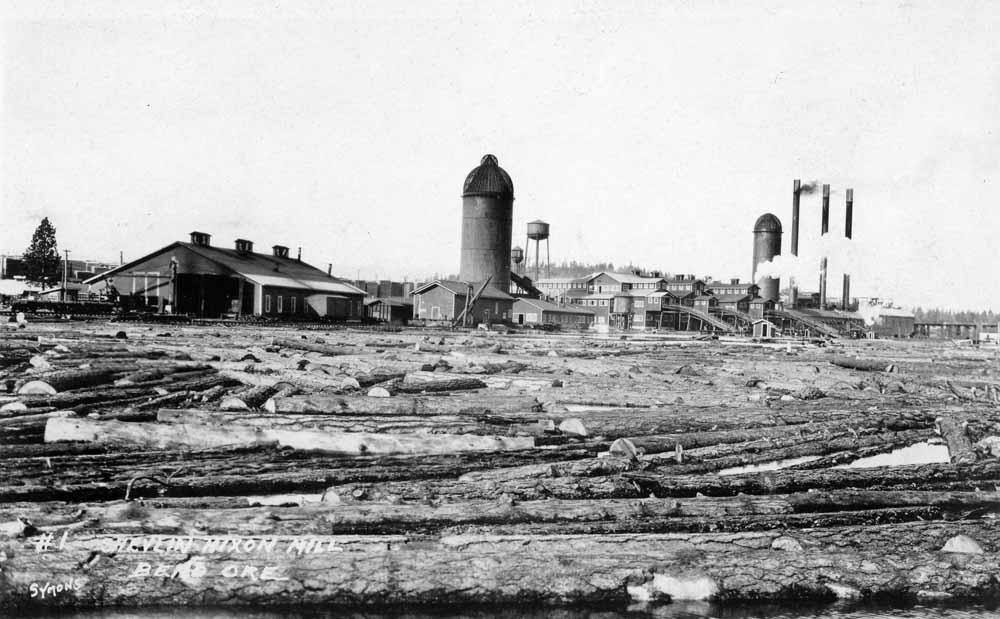 |
|||||||||||||
|
A postcard view of the Shevlin-Hixon mill, with the company's railroad enginehouse to the left. The tender of a steam
locomotive can just be seen inside the enginehouse.
|
|||||||||||||
|
|
|||||||||||||
History The Shevlin-Hixon Lumber Company had its roots in Minnesota when the Shevlin family combined forces with a banker from Wisconsin named Frank P. Hixon. The Shevlin family owned extensive timberlands in Minnesota and Oregon, and the capital that Hixon brought into the combination allowed the company to prosper. Mr. Hixon became president of the company, and T. A. McCann, a cousin of the Shevlins, became manager of their western operations. |
|||||||||||||
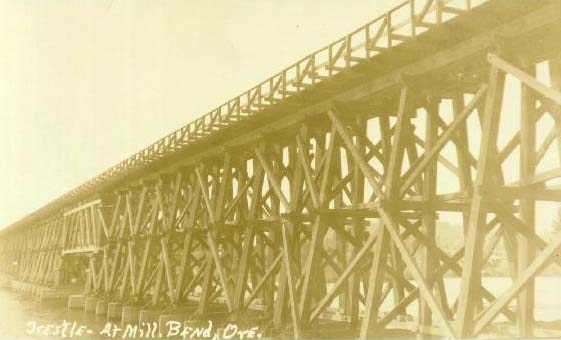 |
|||||||||||||
|
The bridge over the Deschutes River that provided rail access to the Shevlin-Hixon Mill. Marc Reusser collection. |
|||||||||||||
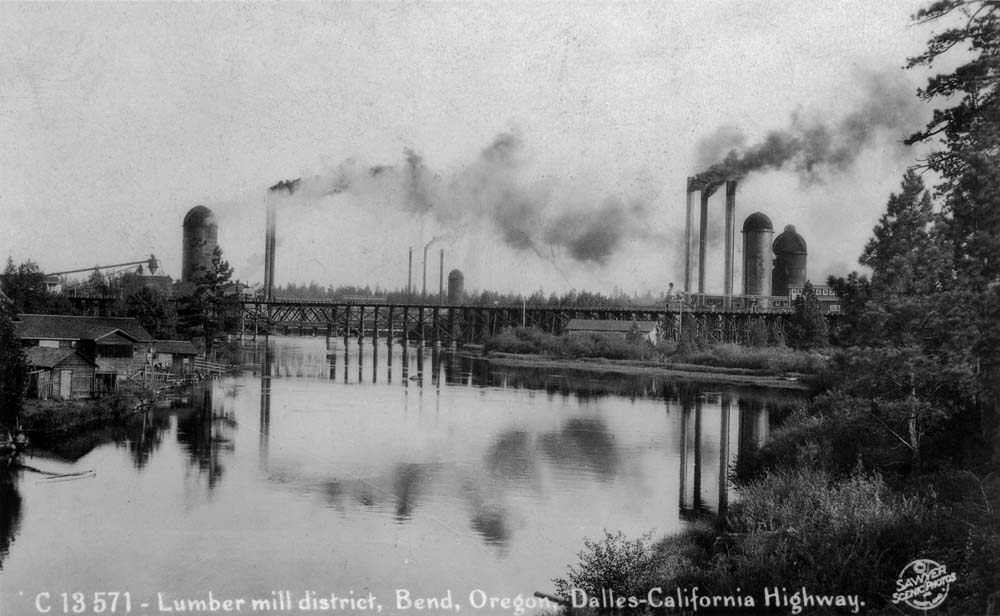 |
|||||||||||||
|
A broadside view of the trestle across the river. The Shevlin-Hixon mill is to the right, with Brooks-Scanlon's Mill A to the left
and Mill B in the center. Jeff Moore collection.
|
|||||||||||||
|
The Shevlin-Hixon company acquired substantial holdings in Deschutes, Klamath and Lake Counties in
central Oregon, containing well over two billion board feet of standing timber. The completion of
the joint Oregon Trunk/Des Chutes railroad into Bend from the north in 1911 provided the transportation
to distant markets required to start large-scale commercial timber operations. Actual
construction of the sawmill did not start until 1915, when the company broke ground just south of Bend on
the west bank of the Deschutes River. The company also started work on a railroad to bring logs to the mill,
and it delivered enough timber into the log pond created by damming the Deschutes River to ensure the sawmill
could start operations on 3 March 1916. Shevlin-Hixon and the Oregon Trunk Railroad jointly built a bridge
across the river to serve the sawmill. The Oregon Trunk had aspirations to build a line south of Bend, and
intended the bridge to be part of the first segment of that line. |
|||||||||||||
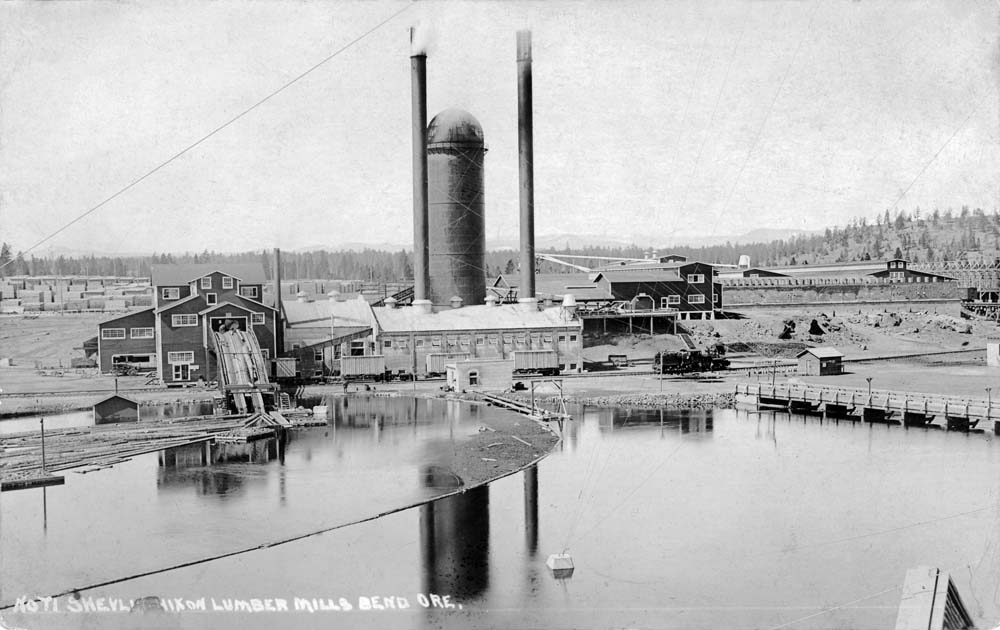 |
|||||||||||||
|
A very early view of the newly completed Shevlin-Hixon mill, with Shay #1 visible to the right of the mill buildings and a string of camp cars on flatcars in front of the mill. Only a single
mill had been completed at the time of this photo.
|
|||||||||||||
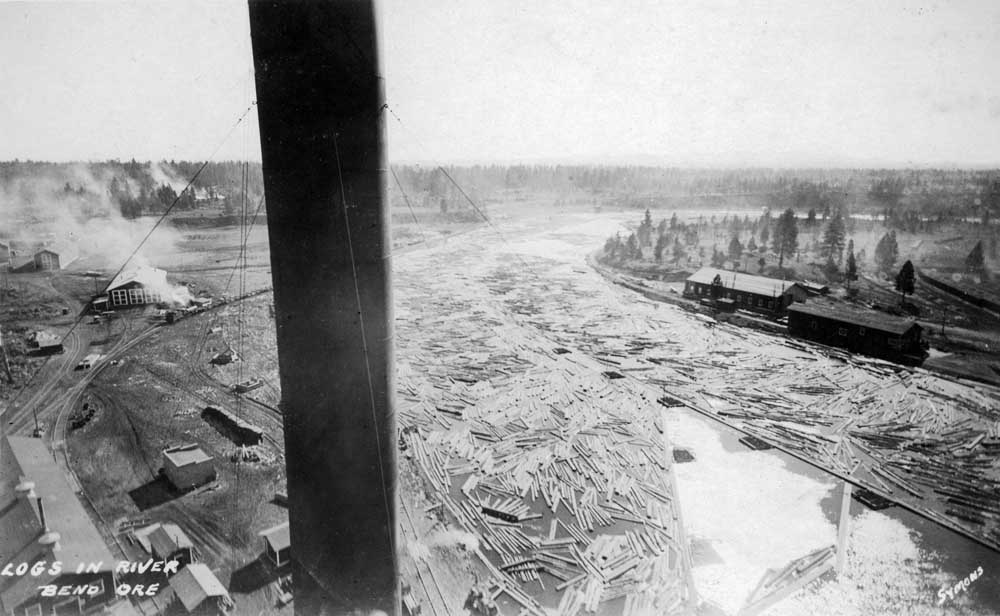 |
|||||||||||||
|
This view, shot from the Brooks-Scanlon mill and looking 90-degrees left from the above image, shows the logs of both companies filling the Deschutes River. The barrier built down the middle of the river to keep
the logs of the two operations apart is visible. The large building in the middle right of the photo is the Shevlin-Hixon enginehouse.
|
|||||||||||||
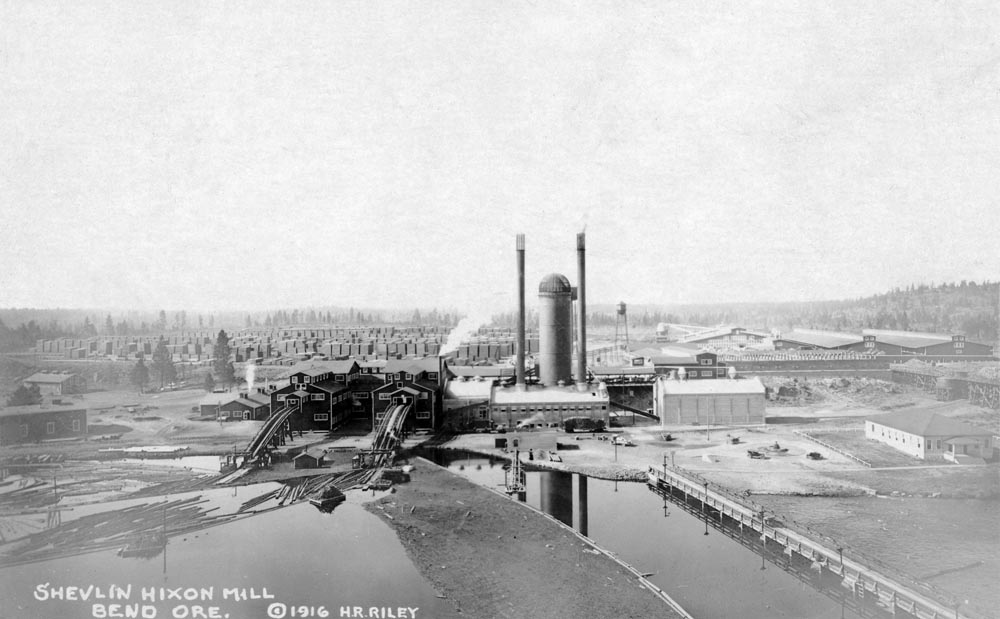 |
|||||||||||||
|
The 1916 copyright date on this postcard shows the company built a second mill building within the first year of operations.
|
|||||||||||||
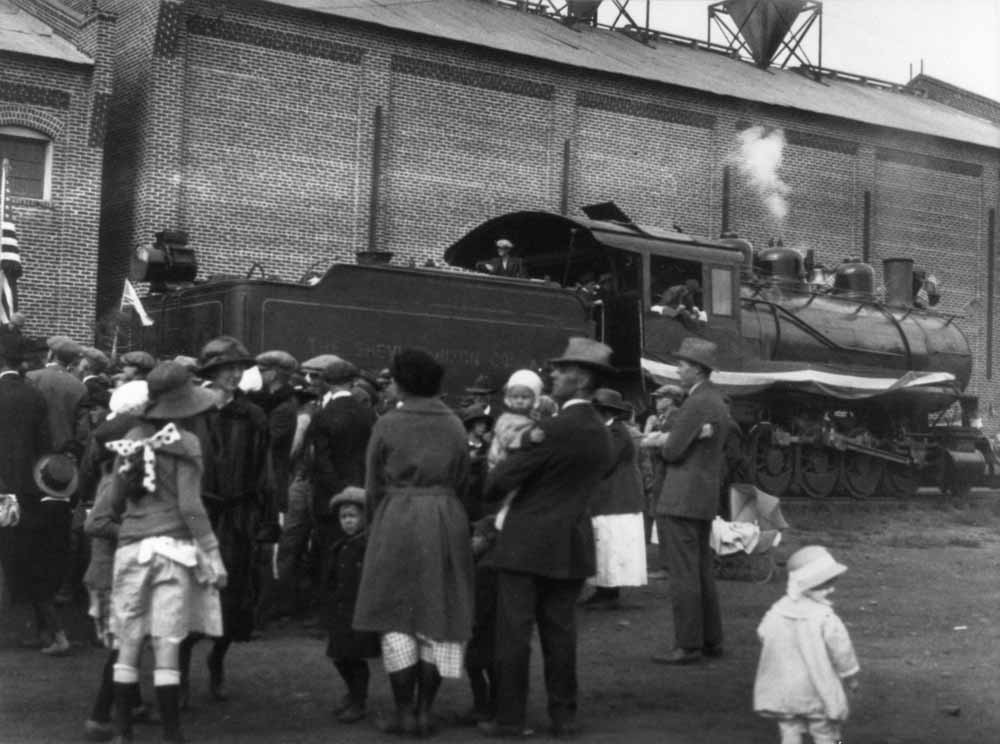 |
|||||||||||||
|
A Shevlin-Hixon locomotive taking part in a community celebration, likely for the July 4th holiday. Jerry Lamper collection.
Initial harvest operations were centered in the hills west of Bend until the timber in that area was
exhausted. Harvest operations then started their march south, with the mainline of the railroad by
1922 running six or seven miles south along the west bank of the Deschutes River to Benham Falls, where
a bridge was built to carry the line to the east bank of the river. The company built a river-to-rail transload
facility just south of the falls, where logs floated down the river from harvest operations farther up
would be removed from the water and loaded onto railcars for shipment to the mill. |
|||||||||||||
 |
|||||||||||||
|
An aerial view
of the two large sawmills in Bend in 1937. The Shevlin-Hixon mill in on the left side of this photograph, with
the sprawling Brooks-Scanlon mill across the river to the right. Downtown Bend lies behind the mills.
Jeff Moore collection.
|
|||||||||||||
|
The scope and scale of Shevlin-Hixon's operations by the middle 1920s are captured the following statistics for
the company as reported in a 1926 lumber industry directory: "Shevlin-Hixon Company, Bend; camp post office, same;
daily output, 650 M; 500 men; 1 donkey engine; machine shop; 3 commissaries; 3 electric light plants; air compressor;
4 Lidgerwood skidders; 1 Clyde skidder; 3 McGiffert loaders; 6 Best 60 logging tractors; 14 sets big wheels; 30 horses;
route supplies via Bend; camp telephone via same; manager, C.L. Isted; superintendent J.H. Meister; purchasing agent N.W.
Boles; master mechanic, Geo. H. Green; 25 miles main line, 30 miles spur s.g. track; 60 lb rail; 6 rod locomotives; 200
sets connected trucks; 3 flat cars; 2 moving cars; 5 tank cars; 5 speeders; maximum grade, 8 per cent on spurs, 2.6 per
cent on main line; maximum curvature, 14 degrees on main line, 28 degrees on spurs; locomotive fuel, oil; 1 locomotive crane." By late 1926 the end of track reached the La Pine area, and a spider web of grades had been built in the country between the town and Paulina Lake. At this point the mighty Great Northern entered the picture, as it finally received permission to build its long-sought line south from Bend to Klamath Falls. The S-H logging railroad lay directly in the path of the contemplated construction, and the GN saw it as a means to reduce the amount of initial construction required to build their new line. The result was that the GN purchased a 75 percent stake in the S-H "mainline" between Bend and La Pine, with S-H retaining the other 25 percent. S-H retained the right to operate log trains over the GN mainline to Bend, with the stipulation that all movements were controlled by the GN and that S-H trains and crews must operate under GN rules. The first GN train ran from Bend to La Pine on 8 September 1927, and construction of the GN line south from La Pine to a connection with the Southern Pacific line at Chemult started shortly thereafter. GN completed the line was on 8 March 1928, and commenced offering through service to Klamath Falls the following May. By this point Shevlin-Hixon owned more than 70,000 acres of prime timber in northern Klamath County, and many businessmen in Klamath Falls hoped that S-H would relocate their sawmill to their city to harvest this timber. Rumors were rampant for a few years, but gradually died away. Except for some timber harvested and milled by a closely affiliated company that was located in Klamath County, logs harvested off of S-H lands went north to Bend.
|
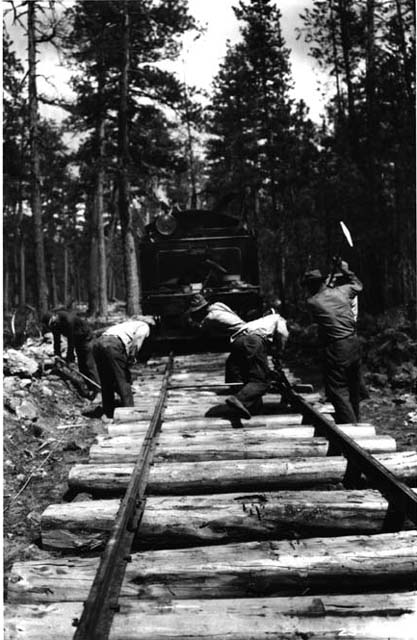
|
A Shevlin-Hixon track crew laying out a spur line south of Bend. U.S. Forest Service collection.
By 1942 S-H harvest operations were in northern Klamath County, with a connection established on the
GN main line at Freemont Siding, about seven miles due east of Gilchrist. This line extended about
sixteen miles east to Big Hole, with several branches built off of this line. By 1947 operations
were moved even farther south, to Chemult. The actual camp was set up approximately 18 miles southeast
of Chemult, and the closest point on the mainline was Diamond Lake siding, which was on the joint GN-SP
line about four miles south of Chemult. However, connecting the logging railroad to the mainline at
that point would have required obtaining trackage rights over the busy SP mainline into Chemult, so
to avoid this problem S-H built four miles of railroad parallel to the SP line to reach a connection
with the Great Northern at the southern end of their trackage just north of the junction
between the SP and GN lines. By the late 1940s it was apparent to both Shevlin-Hixon and Brooks-Scanlon, which also had a huge sawmill in Bend located directly across the river from the S-H mill, that insufficient timber remained in the area that the two mills drew their timber from to sustain operations of both mills for much longer. Local governmental organizations and the U.S. Forest Service had expressed concerns that the two sawmills in Bend were cutting timber at an unsustainable rate for years. The Forest Service had reached this conclusion as early as 1925; a Committee of Sustained Yield Timber Operations established by the Chamber of Commerce in Bend in 1937 concluded that total potential combined output of the two sawmills in Bend was approximately 400 million board feet annually, while the surrounding forests were only capable of providing 100 million board feet annually on a sustained yield basis. By 1944 the figured sustained yield of the forests was downgraded to only 82 million board feet per year. Clearly the sawmills were rapidly running out of trees to cut, and something had to be done to correct the problem before it became more of a crisis. The end result was that Shevlin-Hixon elected to sell out to Brooks-Scanlon. The transaction became effective in November 1950, and the S-H sawmill was promptly closed, with the last load of lumber shipped from the facility leaving four months later. The end of an era was at hand.
|
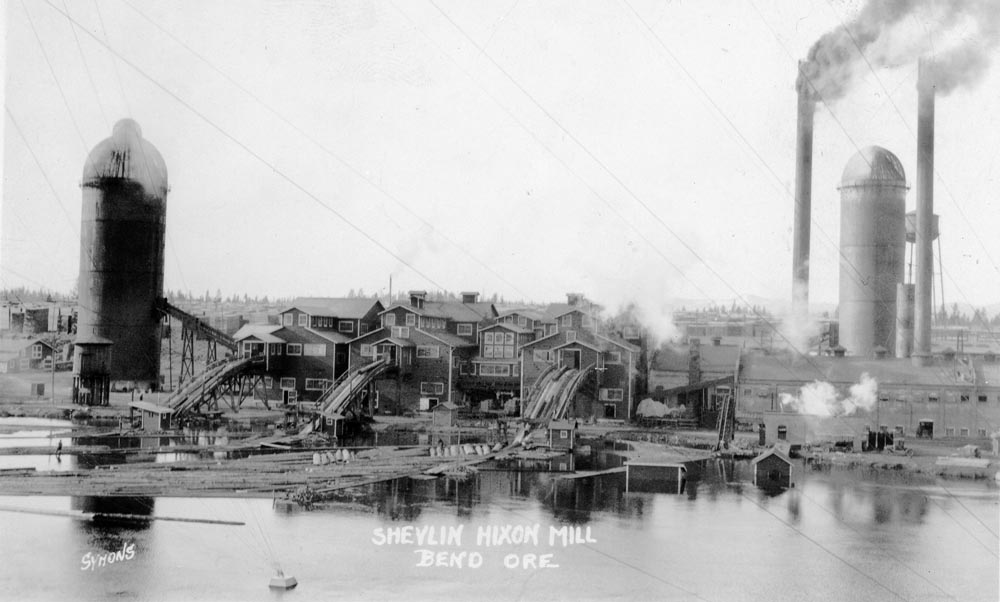
|
The Shevlin-Hixon mills towards the end of the company's operations. Note a third mill building had been added to the complex. Jeff Moore collection.
Brooks-Scanlon continued to run the old Shevlin-Hixon logging railroad operation basically as they
found it, with two major exceptions. First, Great Northern informed the new ownership that the trackage rights
Shevlin-Hixon had over their main line south of Bend would not carry through to the new ownership, and as such
GN started handling the log traffic from the remaining operations to and from Bend. Second, GN started delivering
the logs to the Brooks-Scanlon mill after the Shevlin-Hixon mill closed. Brooks-Scanlong only re-lettered one of the
former S-H locomotive to reflect the new ownership. Coverage of the logging railroad operations
after the B-S takeover can be found on the
Brooks-Scanlon page of this website. | Very little is left to mark the operations that Shevlin-Hixon carried on for thirty five years in central Oregon. Miles of roadbeds can still be found in the woods to the south of Bend, but recent development has obliterated the old mill site in Bend. Those employees that could stay on with B-S did, but many more were forced to leave, with at least some traveling south to take jobs with the McCloud River Lumber Company operations in McCloud, CA, which had been closely affiliated with Shevlin-Hixon for many years prior to the closure of the Bend mill. Perhaps the biggest impact of the closure of Shevlin-Hixon was that harvest levels in central Oregon were finally brought back more in line with what the forests could sustain, and the Brooks-Scanlon mill remained in operation in Bend for another forty or so years before finally closing down. Today Bend is one of the fastest growing cities in the state of Oregon, and it has left much of its timber heritage behind. The forests logged off by Shevlin-Hixon have grown back into new forests, and the current residents are more inclined to let these "virgin" forests stand than those who came before.
|
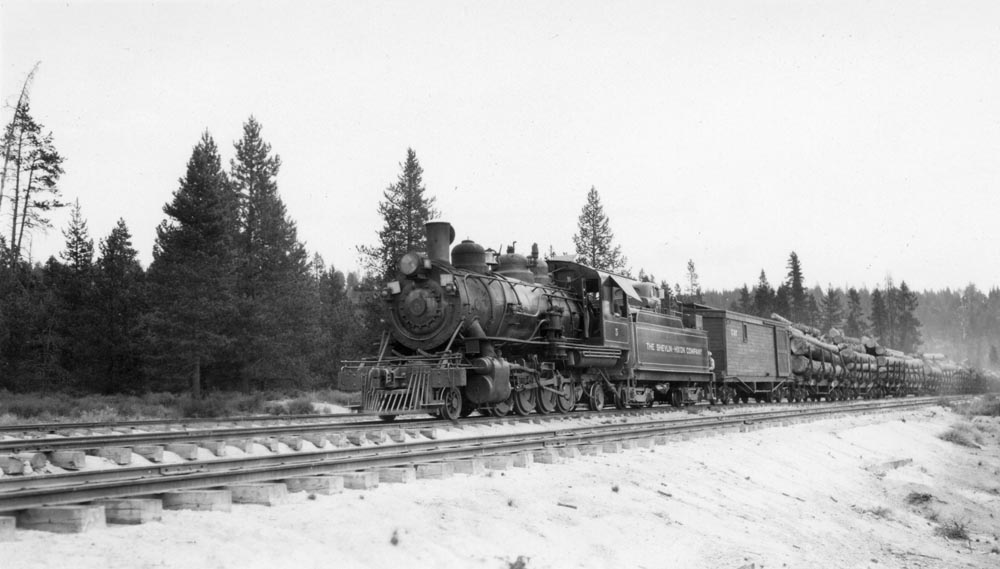
|
Shevlin-Hixon #5 at Chemult waiting for permission to enter the Great Northern main line. Jerry Lamper collection.
|
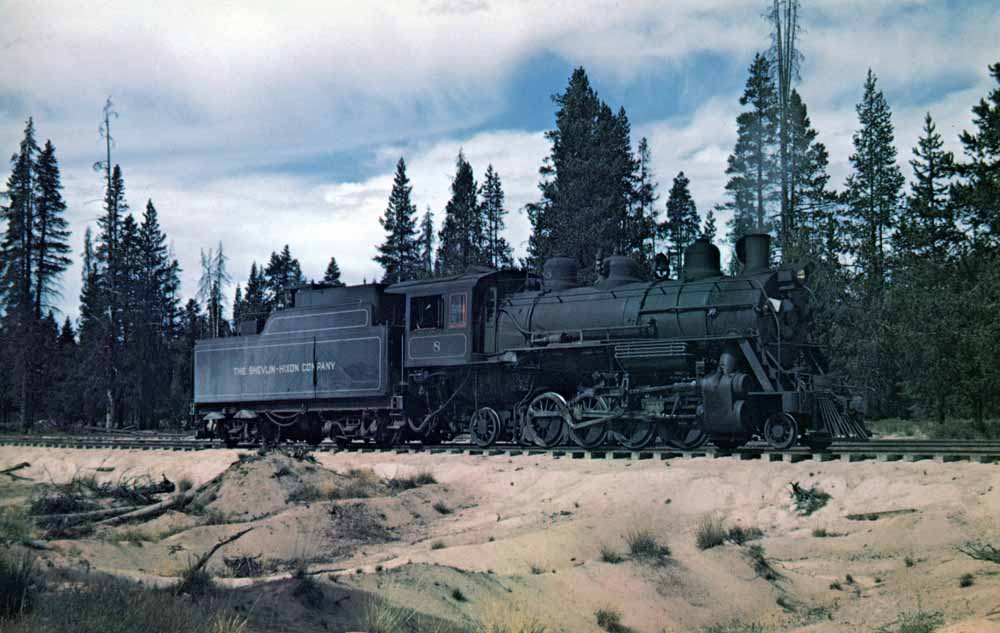
|
A color photo of Shevlin-Hixon #8 at Chemult. Vanishing Vistas postcard from a Guy L. Dunscomb photo.
|
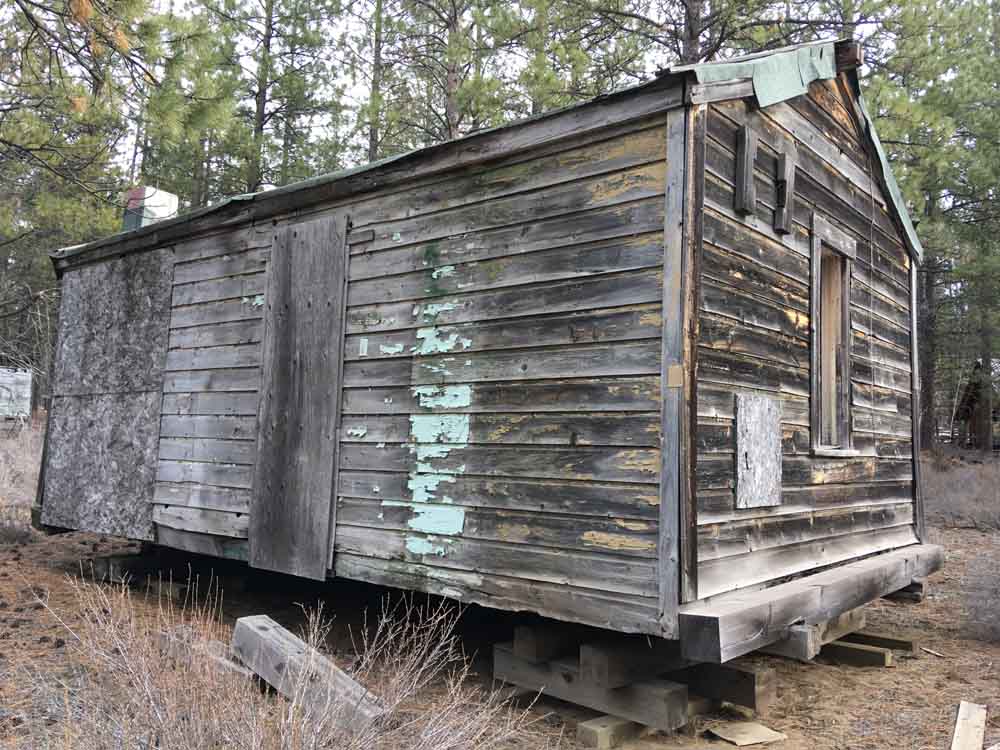
|
One of the few surviving Shevlin-Hixon artifacts is this camp car body at the High Desert Museum south of Bend. The car would have
originally been mounted on wheels but lost those by the 1920s. The boards protruding from the end of the car just below the roof peak were used to guide
cables used to lift the car onto flatcars during camp movements.
|
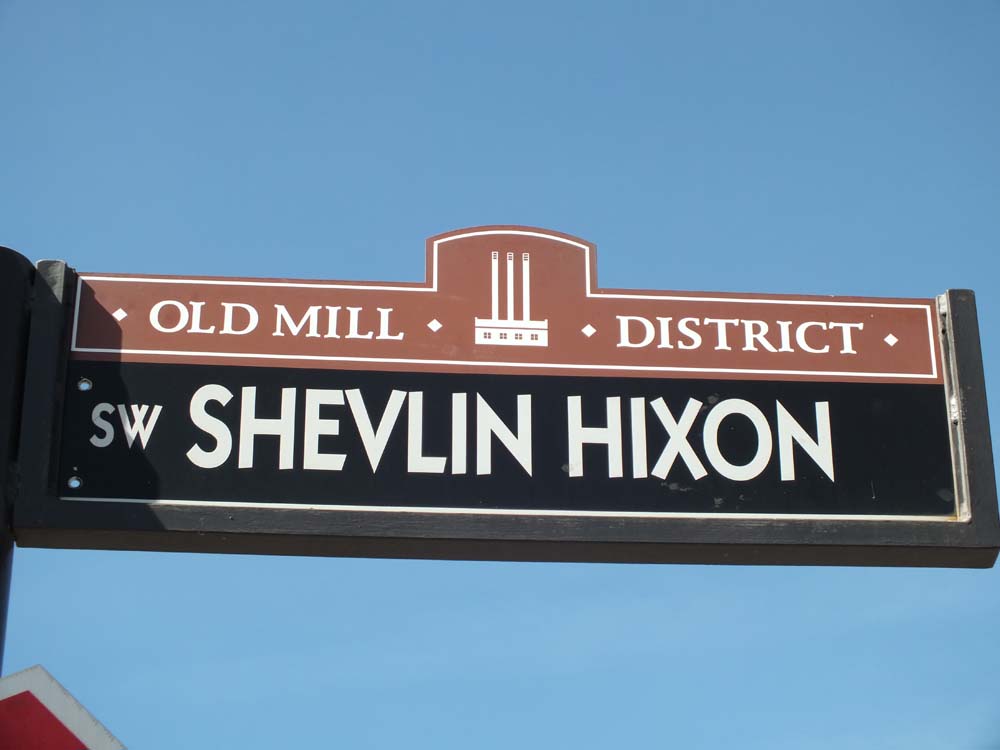
|
Among the most overt traces of Shevlin-Hixon's operations in Bend are place names, such as Shevlin Park out of town and the name of the road that
passes through the middle of the old sawmill site.
|
|
|
|||||||||||||
|
Maps 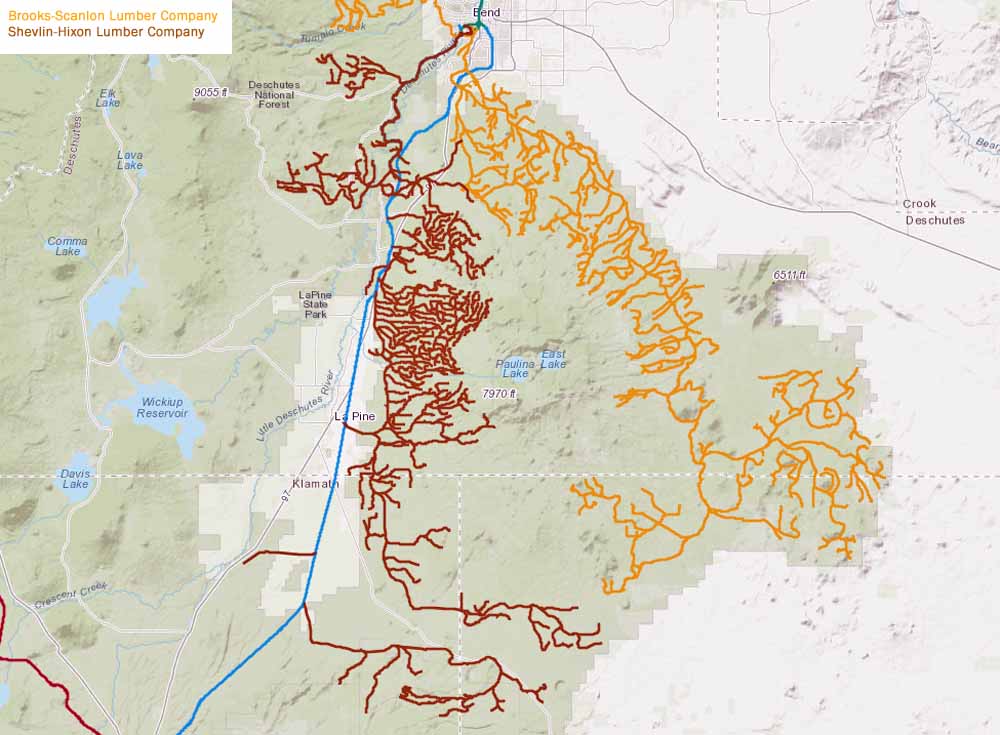
Map of the Brooks-Scanlon and Shevlin-Hixon logging railroads south of Bend. |
|||||||||||||
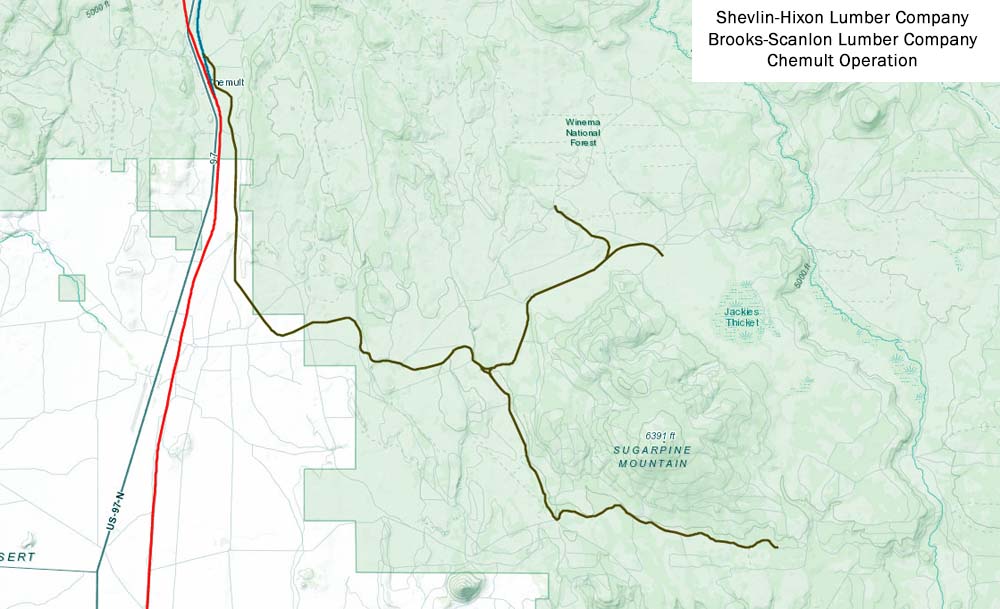 |
|||||||||||||
|
The Chemult logging railroad system.
|
|||||||||||||
|
|
|||||||||||||
Locomotive roster Underlined numbers indicate a link to a page of pictures of that locomotive. #1- Lima 3-Truck Shay, c/n 2821, blt 1915. Cylinders 11"x12", drivers 32", weight 59 tons, tractive effort 25,380 lbs. Purchased new. To Zimmerman, Wells Brown & Company, Portland, OR; to National Lumber & Mfg. Company, Hoquiam, WA; to Schafer Brothers Logging Company #12, Brady, WA; to Mullinix Brothers Logging Company #12, Pe Ell, WA, 1938. #2- Baldwin 2-8-2, c/n 43210, blt 4/1916. Cylinders 18"x24", drivers 44", boiler pressure 180 lbs, weight 139,000 lbs., tractive effort 27,000 lbs. Purchased new. To Brooks-Scanlon 1950, but never re-lettered or re-numbered. Scrapped. #3- Lima 3-Truck Shay, c/n 2941, blt 1917. Cyliners 12"x15", drivers 36", weight 75 tons, tractive effort 30,350 lbs. Purchased new. To Eagle Lumber Company, Westimber, OR; to C.H. Wheeler Company, Cochran, OR; to Blue Lake Logging Company, Cochran, OR, 1928; to Columbia Contract Company, Astoria, OR, 1932; Scrapped 1953. #4- Baldwin 2-8-2, c/n 51907, blt 6/1919. Cylinders 18"x24", drivers 48", boiler pressure 170 lbs., weight 175,500 lbs, tractive effort 35,400 lbs. Purchased new. To Brooks-Scanlon 1950, only ex-Shevlin-Hixon locomotive re-lettered to reflect new ownership. Re-numbered "S-H 4" by B-S to avoid duplication with B-S's own #4. Scrapped. #5- Baldwin 2-8-2, c/n 55805, blt 11/1922. Cylinders 18"x24", drivers 44", boiler pressure 185 lbs, weight 143,000 lbs, tractive effort 27,800 lbs. Purchase new. To Brooks-Scanlon 1950, but never re-lettered or re-numbered. Scrapped. #6- Baldwin 2-8-2, c/n #56111, blt 2/1923. Cylinders 18"x24", drivers 44", boiler pressure 185 lbs., weight 143,000 lbs., tractive effort 27,800 lbs. Purchased new. To Brooks-Scanlon 1950, but never re-lettered or re-numbered. Scrapped. #7- Baldwin 2-8-2, c/n 53251, blt 5/1920. Cylinders 19"x24", drivers 42", boiler pressure 185 lbs., tractive effort 32,500 lbs. Built as a 2-8-2T (square-rectangular water tanks mounted along the boiler, instead of the typical over the boiler arrangement) for Wisconsin Logging & Timber Company #7; to Shevlin-Hixon #7. S-H removed the water tanks and added a tender . To Brooks-Scanlon 1950, but never re-lettered or re-numbered. Scrapped. #8- Baldwin 2-8-2, c/n 57708, blt 4/1924. Cylinders 20.5"x28", drivers 48", boiler pressure 170 lbs., weight 88 tons, tractive effort 35,400 lbs. Purchased new. To Brooks-Scanlon 1950, but never re-lettered or re-numbered. Scrapped. |
|||||||||||||
|
|
|||||||||||||
|
Photos of the Shevlin-Hixon Lumber Company Shevlin-Hixon Logging Equipment Shevlin-Hixon Railroad Equipment Log Train Photos Log Camp Photos Wrecks |
|||||||||||||
|
|
|||||||||||||
|
References Books "Railroad Logging in the Klamath Country". Jack Bowden, Oso Publishing, 2004. "Green Gold: The incomplete, and probably inaccurate, history of the timber industry in parts of Central and Eastern Oregon from 1867 to near the present". Martin Gario Morisette, self published, 2005. Periodicals "Brooks-Scanlon, Inc." by Jack M. Holst, February 1970 Pacific RailNews: Pgs 4-17. "Closing the Lumberman's Frontier: The Far Western Pine Country" by Thomas R. Cox, July 1994 Journal of the West: Pgs 59-66. |
|||||||||||||
|
|
|||||||||||||